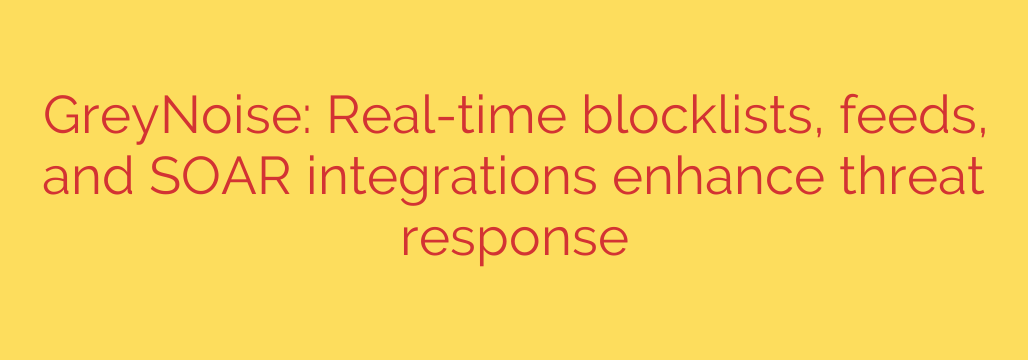
Cut Through the Noise: How to Supercharge Your Threat Response and Reduce Alert Fatigue
Security Operations Centers (SOCs) are drowning. Day after day, security analysts face a relentless tsunami of alerts from firewalls, SIEMs, and other detection systems. The problem? A vast majority of this traffic isn’t a targeted attack—it’s just “internet noise.” This background chatter, generated by mass scanners, search engine crawlers, and misconfigured services, creates a critical challenge: alert fatigue.
When analysts spend their days chasing down thousands of low-priority or benign alerts, their ability to spot genuine, sophisticated threats diminishes. It’s like trying to hear a whisper in a hurricane. To truly enhance threat response, security teams need a smarter approach—one that separates the signal from the noise.
The Problem: Why Most Threat Intelligence Fails
Traditional threat intelligence often operates on a binary model: an IP address is either “good” or “bad.” While this is useful, it lacks the necessary context for modern security operations. An IP address scanning your network might be a malicious actor looking for vulnerabilities, but it could just as easily be a harmless research project or a new search engine bot.
Treating both scenarios with the same level of urgency is inefficient and leads to wasted resources. Your team ends up spending precious hours investigating activity that poses no real threat, pulling them away from the critical work of threat hunting and incident response.
A New Paradigm: Context-Aware Threat Filtering
Imagine if you could instantly identify and ignore the vast majority of internet-wide scanning activity. This is the power of context-aware threat intelligence. Instead of just flagging an IP as “bad,” this approach classifies IPs based on their intent and behavior across the entire internet.
This allows security teams to answer critical questions instantly:
- Is this IP address opportunistically scanning the entire internet, or is it specifically targeting our organization?
- Is this a known benign scanner from a university or a tech company?
- Is this IP associated with common malware or a specific threat actor?
By having this context upfront, security teams can transform their workflow from reactive to proactive.
Key Capabilities to Fortify Your Defenses
To effectively filter out noise and focus on real threats, modern security platforms should provide several core capabilities that integrate directly into your existing security stack.
1. Real-Time, Dynamic Blocklists
Static blocklists become outdated almost as soon as they are published. A modern approach uses dynamic, real-time blocklists that are continuously updated. More importantly, these lists should be based on observed behavior. By using a feed of IPs known to be engaged in harmless mass scanning, you can proactively block this traffic at the firewall level. This means the noise never even generates an alert, dramatically reducing the workload on your SIEM and your security team.
2. Actionable, Context-Rich Intelligence Feeds
Your team needs more than just an IP address; they need the story behind it. An effective intelligence feed doesn’t just provide a list of IPs—it provides context. This includes information on:
- Classification: Is the IP malicious, benign, or unknown?
- Intent: Is it conducting mass scanning or targeted attacks?
- Attribution: Is it associated with a specific actor, malware, or vulnerability (like Log4j scanners)?
This level of detail allows an analyst to make a faster, more accurate decision about an alert’s priority in seconds, not hours.
3. Seamless SOAR and SIEM Integration
The true power of this intelligence is unleashed when it’s automated. Deep integration with Security Orchestration, Automation, and Response (SOAR) platforms and SIEMs is essential. By connecting these tools, you can automate the triage process.
For example, when an alert comes in, your SOAR playbook can automatically query the intelligence source. If the IP is identified as a benign internet scanner, the ticket can be automatically de-prioritized or closed. If it’s flagged as malicious or specifically targeting your assets, the ticket can be immediately escalated with all the relevant context attached. This allows your team to enrich security alerts automatically, saving valuable time and ensuring human expertise is focused only on the most credible threats.
Actionable Security Tips for a Quieter SOC
Implementing this strategy can fundamentally change how your security team operates. Here are a few tips to get started:
- Focus on High-Fidelity Alerts: Actively filter out alerts from known mass scanners. This ensures that the alerts your team sees are more likely to be legitimate threats worthy of investigation.
- Automate Your Initial Triage: Use SOAR integrations to handle the low-hanging fruit. Let automation decide if an IP is part of the internet’s background noise so your analysts don’t have to.
- Enrich Every Alert: Before an analyst even looks at a ticket, make sure it’s enriched with context. Knowing an IP’s history, intent, and classification is the key to fast, effective incident response.
By shifting from a strategy of blocking everything “bad” to intelligently filtering out the “noise,” security teams can finally escape the cycle of alert fatigue. This allows them to focus their energy where it matters most: on stopping genuine threats and securing the organization.
Source: https://www.helpnetsecurity.com/2025/07/31/greynoise-new-platform-capabilities/








